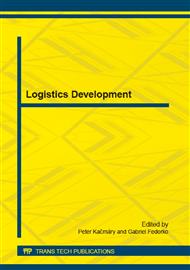[1]
A. Rosova, Analysis of corporate logistic processes and their modelling, VSB TU Ostrava, Ostrava, (2013).
Google Scholar
[2]
X. Lukoszova, et al., Logistics technologies in the supply chain, Ekopress Ltd. Praha, 2012. (original in Czech).
Google Scholar
[3]
A. Saniuk, S. Saniuk, Rapid prototyping of constraint-based production flows in outsourcing, Advanced Materials Research. 44-46 (2008) 355-360.
DOI: 10.4028/www.scientific.net/amr.44-46.355
Google Scholar
[4]
J. Saderova, P. Kacmary, The simulation model as a tool for the design of number of storage locations in production buffer store, Acta Montanistica Slovaca. 18-1 (2013) 33-39.
Google Scholar
[5]
S. Saniuk, A. Saniuk, R. Lenort, A. Samolejova, Formation and planning of virtual production networks in metallurgical clusters, Metalurgija. 53-4 (2014) 725-727.
Google Scholar
[6]
P. Trebuna, Experimental modeling methods in Industrial Engineering, Acta Montanistica Slovaca. 14-4 (2010) 335-340.
Google Scholar
[7]
M. Straka, Logistics of distribution, How effectively to put product into the market, EPOS, Bratislava, 2013. (original in Slovak).
Google Scholar
[8]
M. Straka, System of distribution logistics of enterprise Alfa, a. s., Acta Montanistica Slovaca. 15-1 (2010) 34-43.
Google Scholar
[9]
R. Kampf, P. Prusa, C. Savage, Systematic location of the public logistic centres in Czech Republic. Transport. 26-4, (2011) 425-432.
DOI: 10.3846/16484142.2011.635424
Google Scholar
[10]
P. Bindzar, J. Izolova, M. Balog, Projectc conception for city logistics with utilization of IDS element applicated to the Nitra city, Acta Montanistica Slovaca. 15-1 (2010) 73-81.
Google Scholar
[11]
R. Kampf, J. Lizbetin, L. Lizbetinova, Requirements of a transport system user, Komunikacie. 14-4 (2012) 106-108.
DOI: 10.26552/com.c.2012.4.106-108
Google Scholar
[12]
I. Liberko, P. Trebuna, Improving of business ethics with benchmarking methods, Acta Mechanica Slovaca. 10-3 (2006) 51-56. (original in Slovak).
Google Scholar
[13]
M. Antosova, A. Csikosova, K. Culkova, A. Senova, Benchmarking research of steel companies in Europe, Metalurgija. 52-3 (2013) 410-412.
Google Scholar
[14]
R. Klepek, R. Lenort, M. Straka, Modelling and simulation of permeability of heat treatment of forged pieces, Metal. (2011).
Google Scholar
[15]
J. Saderova, P. Kacmary, Application of the simulation of a tank capacity proposal for loading and unloading process of bulk material, Acta Montanistica Slovaca. 17-3 (2012) 143-150.
Google Scholar
[16]
P. Bindzar, D. Malindzak, Number of conveyor belts optimization regarding to its type and logistical parameters in mining industry, Acta Montanistica Slovaca. 4 (2008) 524-531. (original in Slovak).
Google Scholar
[17]
A. Csikosova, M. Antosova, K. Culkova, Marketing of renewable energy sources in the region, Acta Montanistica Slovaca. 17-4 (2012) 315-321.
Google Scholar
[18]
P. Prusa, D. Tilkeridis, Possibilities of Logistics Policy Improvement, Promet. 21-21 (2009) 123-127.
DOI: 10.7307/ptt.v21i2.218
Google Scholar


